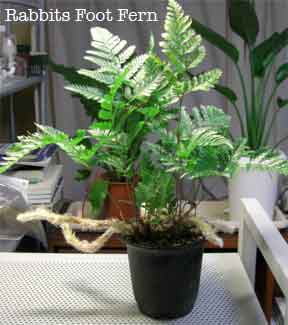
The Rabbit’s Foot Fern – To many people, every fern with long slender, furry runners over the side of the pot is a “rabbit’s foot” fern.
Their grandmother had one; she called it that and that is what it is, as far as they are concerned.
To a certain extent they are right, but to true “fern fanciers” they distinguish among “hare’s foot,” “bear’s foot” and “squirrel’s foot.” As hares are called rabbits in the US, however, probably “rabbit’s foot” is as good a name as any.
Over the years I’ve been fairly successful in growing some of these. These ferns grow easily. Mine have thrived in an enclosed porch or “mini” conservatory connected with the house.
The door between is always open and the temperature is only a little cooler than that of the house, except at night, when it is probably 10 to 12 degrees cooler. They get practically no sunshine during winter. In summer I hang them under rather dense trees, where they receive only filtered light.
The ferns are potted in a sandy loam with about one-hail leafmold, I’ve also used 2/3 peatmoss and 1/3 perlite and watered two or three times a week. The rhizomes grow along the top of the soil and should never be covered. I’ve grown some in pots but mostly as hanging plants.
In fact, they can hardly be grown in any other way, after they get to be any size. Most of mine are six or eight years old, and have been repotted only once, when they became firmly established from cuttings.
Two or three times a year, particularly in winter, I feed them with some liquid plant food – it doesn’t seem to make much difference what. They usually respond with new fronds in a short time.
One of those you will want to try is Davallia tyermannia which is more often called bear’s foot rather than rabbit’s foot. Davallia divaricata is also interesting and beautiful. The young fronds are bright red, turning green with age. Perhaps the most finely cut and graceful of all is the handsome Davallia fijensis.
Davallia ferns are easy to propagate. A piece of the “foot” – the rhizome – cut from the plant will usually root if pinned down to sphagnum moss and kept warm. Another way is to pin them to a pot of soil, and cut them from the parent plant when they have rooted.
There are many other intriguing varieties of ferns are grown. If you are successful in rabbit foot fern care and you have space, try your hand at staghorn fern care. They are truly unique plants.
Images: i-saint


{ 0 comments… add one now }
You must log in to post a comment.